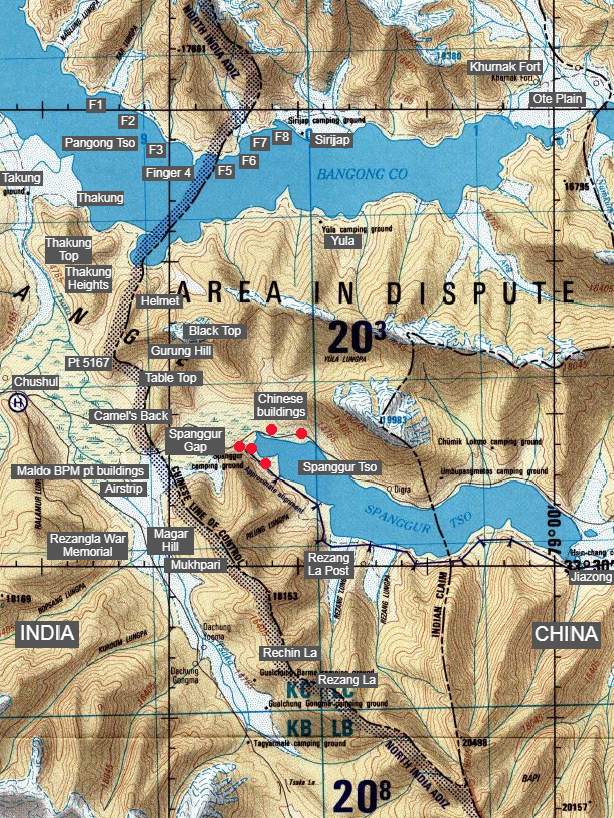India and China have achieved a significant breakthrough in their ninth round of commander level disengagement talks and on Feb. 11 both the countries announced an agreement for disengagement at the North and South Bank of Pangong-Tso. The Chinese Defence Ministry called it to be a “Synchronized and Organized” disengagement and India’s Defence Minister Rajnath Singh assured in the Parliament that “…both the sides will cease their forward deployments in a phased, coordinated and verified manner.” As a result, the disengagement at the Northern and Southern Pangong-Tso is almost complete and as for the resolution, India has agreed to restrict themselves or its troops up to Finger-3 at Dhan Singh Thapa Post and China up to Finger-8 in the Fingers-Area of the Northern Pangong-Tso at Sirijap.
Both the countries have been engaged in an ongoing 11-month border standoff in eastern Ladakh. In April last year, the PLA pre-empted India and intruded at the Galwan valley, Fingers area of Pangong-Tso and Gogra-Hotsprings-Kongka-La and occupied vantage points across the LAC. The friction and escalation led to hand-to-hand combat on June 14, which led to the death of 20 Indian soldiers and five PLA soldiers, which is only acknowledged a few days ago. While the negotiations were ongoing between both sides, the Chinese pre-empted India again and opened a new front at Depsang Plains. To counter the Chinese actions, on Aug. 29 last year the Indian Army conducted a tactical operation on the south bank of Pangong-Tso and occupied the crucial vantage points of the Kailash Ranges. The tense situation also led to the firing of shots by both sides for the first time in forty-five years.
The Joint Press-Release by both the governments after the Tenth round of disengagement talks termed the resolution for disengagement as a “good basis for resolution of other remaining issues along the LAC (Line of Actual Control).” While both the governments are declaring this to be a win-win situation, it is important to note that the statement neither mentions the other friction vantage points such as Gogra, Hot-Springs, Depsang and Demchok nor does it provide a timeframe of the further disengagement across the LAC.
Albeit it is a significant outcome and possibly could be the beginning of the end of the 11-month border standoff, India should continue to be vigilant and prudent because China likes to negotiate. The buffer zone which has been created between Finger-4 and Finger-8 seems to have benefitted China’s goal of denying India to patrol, deploy and restrict infrastructure development. The official LAC runs through the Finger-8, up to which Indian troops used to patrol and lay claim. However, by restricting itself to Finger-3 and the buffer zone completely falling on the Indian side of the LAC, it favours China.

As a part of the agreement reached, India also disengages and withdraws from the heights of Kailash Range, the Southern bank of Pangong-Tso. The vantage heights such as Black Top, Helmet Top, Rechin-la and Rezang-La of the Kailash ranges are of high strategic importance because the control over these heights threaten to push the People’s Liberation Army (PLA) up to the international border as it existed in 1947 if the situation escalates and leads to limited war. By withdrawing from the vital vantage heights of the South Pangong, India seems to have given away its most crucial strategic leverage to restore status-quo ante.
With India losing the military leverage of the heights of Kailash Range, the way ahead looks grim for the negotiations. The disengagement at Gogra-Hot-Springs could also be done on the lines of disengagement at Pangong-Tso by creating a buffer zone on the lines of 1959 claim line. The 1959 claim line was proposed by the then China’s Prime Minister Zhou Enlai to then Indian Prime Minister Nehru that both the armies to withdraw 20km from McMohan Line in Ladakh. Any buffer zones that completely fall on the Indian side of the LAC at Gogra-Hot-Springs will halt India’s development of roads along the Kugrang river and Changlung-Nala, which are vital border infrastructure.
However, in negotiations regarding Depsang Plains and Demchok, which Defence Minister Singh referred to as “outstanding issues”, India should not seem eager for disengagement and not favour buffer zones given its high strategic importance. Demchok could be very problematic because India has been trying to raise the particular issue during the negotiations and if reports are to be believed PLA has laid optical-fibres and built 5G infrastructure.
India has been firm on its position and the Indian Army’s capabilities in the icy-cold Ladakh winters made PLA’s Ladakh adventure costly. Due to the various economic, diplomatic and military responses India has been able to thwart, China’s Ladakh adventure. However, due to the lack of trust in each other and the weight of “outstanding issues”, the road for complete disengagement is a long way.
Ever since the start of China’s aggression, its state media has been largely silent on the standoff but ever since it acknowledged the death of its troops at Galwan, the social media of China has been agitated and debating over the disengagement. Disappointed Chinese people coupled with jingoism could make it difficult for negotiations. The possible way ahead for India is to stand firm and continue the negotiations and should resist the creation of buffer zones that favour China. With India no longer in control of the Kailash Range, it should be ready to pre-empt the PLA if the required agreement is not reached. Unless a complete disengagement is reached at Depsang and Demchok, the idea of restoring status-quo ante is an illusion and consider Doklam has been repeated by China with its “two steps forward, one step back” play card.
The views and opinions expressed in this article are those of the author.


